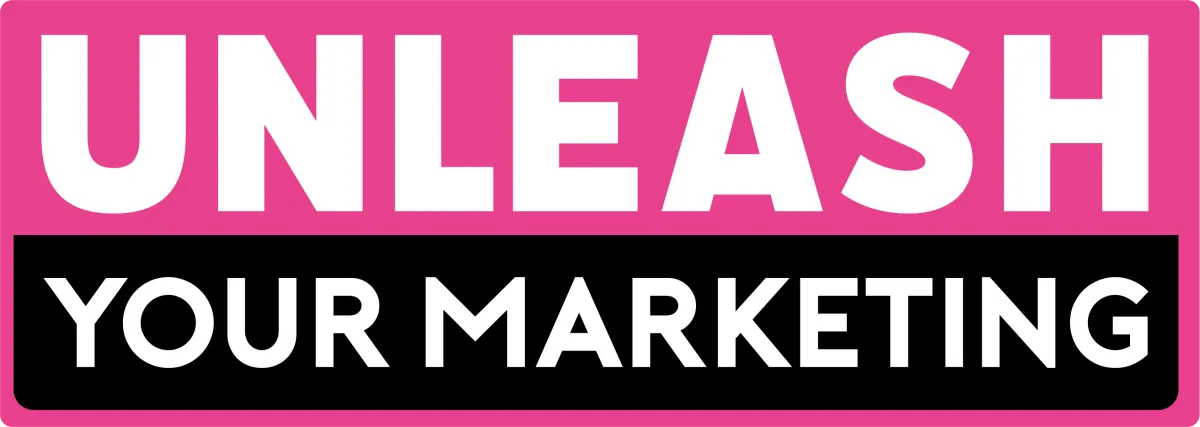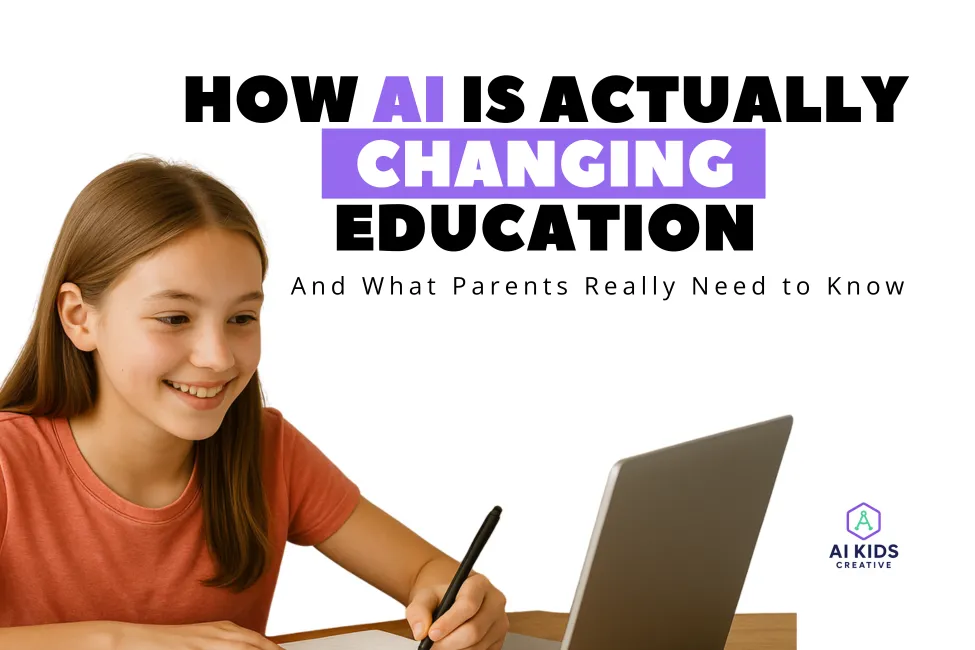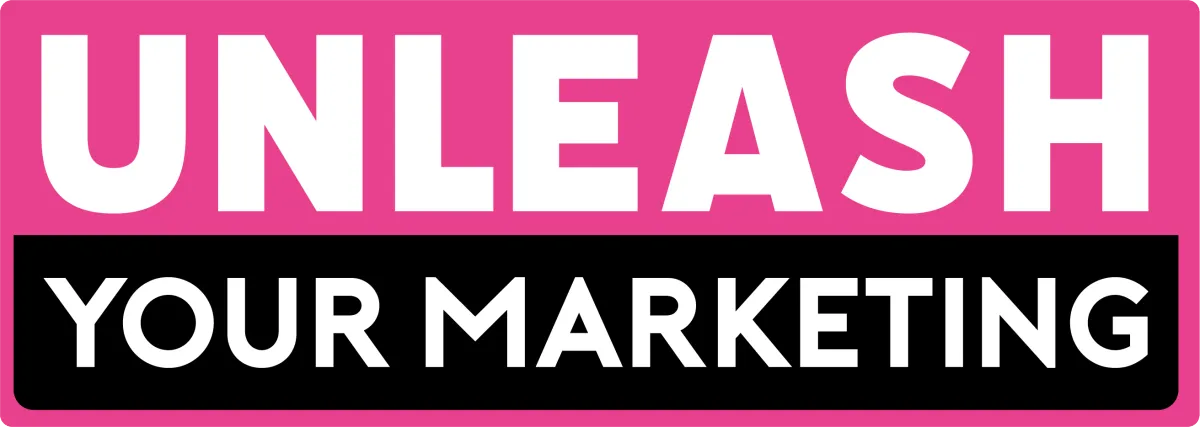
Marketing & AI Digest
Tips & Tricks to help you unleash the marketing in your business

How AI Is Actually Changing Education and What Parents Really Need to Know
“We cannot prepare our children for tomorrow by clinging to what worked yesterday.” - Anonymous (but very wise)
I used to think AI was for tech wizards or the kind of people who build robots in their garage for fun.
Not for me. Not for my kids. Definitely not for my kitchen table where crayons, lego, books and coffee cups all live in harmony - or chaos, depending on the day.
But then I saw what was coming.
Suddenly, AI isn’t this futuristic thing anymore. It’s already in our kids’ classrooms at home or in school. It's in their homework. It's on the apps they use. One minute it’s being praised as the magic bullet for personalized learning. The next, it’s being blamed for cheating, distraction, and a total lack of original thought.
So yeah, if you're feeling both curious and cautious - you’re not alone.
This isn’t a fear-fest. It’s not a hype train either. It’s a map. A grounded, no-jargon, straight-talking guide for parents who want to raise kids that think, not just tap and type.
Let’s pull back the curtain on how AI is actually being used in education, what’s predicted to come next, and how you can guide your kids through it without losing your mind or their childhood.

The Electricity of Our Era
Artificial intelligence (AI) is what the experts call a general purpose technology. This means, it’s not just another gadget. It’s like electricity. It will quietly become part of everything.
We’re not even close to the big wave yet. This moment? We’re at 1992 internet vibes. The Googles and Amazons of AI haven't even been built yet.
But already, one thing is clear: Focus is now a superpower.
In a world built to distract, raising a kid who can think deeply and stay present might just be the ultimate rebellion. The challenge is real.
The The Big 3 Every Parent Needs to Know
1. Safe, Informed Use
Let’s get this straight.
AI is not a best friend. It’s not a therapist. It’s not the magic homework genie either.
It’s a tool. And a powerful one.
Teach your kids:
Don’t overshare. AI tools don’t need your secrets to work.
Ask smart questions. The quality of what you get depends on how you ask.
Don’t trust blindly. Fact-check, verify, and stay curious.
Curiosity is gold but only if you teach them how to filter the noise.
2. We Must Rethink What We Teach
AI is already helping with schoolwork at home. So what’s school for now?
Here’s a better model:
Use AI for content and research outside the classroom.
Use school time for thinking, debating, and problem-solving.
Surprise quizzes, real-world scenarios, and no more cookie-cutter learning.
Because the goal isn’t just to pass tests anymore. It’s to build minds that won’t crack under the pressure of a fast-changing world.
3. The System Needs a Redesign
Throwing laptops and software into schools without strategy? That’s digital duct tape.
What we really need:
Curriculum architects who understand this shift.
Systems that prepare kids for quantum computing and polymath robots, not just the next standardized test.
Teachers who are not overworked tech babysitters - but strategic mentors.

What Kids Actually Need to Thrive with AI
Here’s your cheat sheet. No jargon. Just real-life essentials.
Critical Thinking + Discernment: AI can be a brilliant tool or a blindfold. It all depends on who's holding the mouse. We need kids who know how to pause, question, and say, “Hmm… is that actually true?” It's the difference between following instructions and becoming an innovator.
Strong Reading Skills: Reading fuels comprehension and imagination. Still non-negotiable.Yes, even now. Especially now. Reading builds the mental muscles AI can’t touch. Comprehension, imagination, and empathy. A child who reads isn’t just decoding words. They’re building worlds. AI might summarize a chapter, but it can’t spark the same fire that a great book does.
Play: Because innovation doesn’t happen in perfectly structured Google Docs. It grows in real, messy, unstructured play in cardboard castles, LEGO cities, and experiments gone sideways in the backyard. When a child makes something out of nothing - that’s innovation. And no algorithm can replicate that.
Cross-Subject Thinking: Teach them to connect science to art to history. That’s where genius lives. In the real world, subjects don’t live in silos. Neither should our kids’ thinking. Let them see how art connects to math, how history informs science, how storytelling can explain data. The future belongs to the curious kids who can zoom out and connect the dots.
Confidence + Self-Reliance: Not the puffed-up kind that says, “I know everything.” The kind that says, “I’ll figure it out.” The kind that survives a coding bug or a science experiment fails without melting down. In an AI world, the kids who succeed will be the ones who don’t give up when things aren’t pre-written for them.
Public Speaking + Expression: AI can help refine, but kids still need to show up with a strong voice. AI can help shape ideas. But it can’t deliver them with passion. It can’t walk into a room and speak from the heart. That’s your child’s job. Their ability to communicate clearly, confidently, and compassionately will never go out of style.
Human-Centered Thinking: Ask, “How will this help others?” AI can optimise. But can it care? It does not have a soul. Teach your kids to always ask: “Who does this help?” “What are the consequences?” The best inventors and leaders in the AI era won’t be the ones with the flashiest tools. They’ll be the ones who use those tools to serve others.
Reflection Time: AI may speed things up. But wisdom still needs pause. In a world that moves faster by the second, our kids need to learn how to stop. To think. To breathe. AI might be built for speed, but wisdom only comes when there’s room to pause. Even if that pause looks like staring out the window or journaling after dinner.
Real-Life AI in Education: The Good, the Weird, and the Worrying
Duolingo: AI + gamification = millions learning languages with glee.
Harvard Physics Study: AI feedback helped students double test scores.
Alpha School: Two hours of AI-powered learning. The rest? Public speaking, life skills, confidence-building.
University Study: AI did help with homework... but students did worse on tests. Hmm.
ChatGPT & Cheating: If your school hasn’t addressed this yet, it’s already behind.

Let’s Talk About the Dark Side
Now, I’m not here to say AI is evil. I use it. I teach it. I even wrote this blog with the help of it.
But just like with anything powerful including cars, fire and scissors in the hands of toddlers, there’s a darker side if we don’t handle it wisely. Especially when kids are involved. So let’s name the things no one really wants to say out loud, but parents need to know.
AI Chatbot Addiction
Kids are forming emotional bonds with bots. Yes, really. They’re chatting with AI companions that learn how to sound caring, curious, even flirtatious. And the problem isn’t just that it’s “weird.” It’s that it feels real - especially to a young, lonely, or emotionally vulnerable child.
What’s marketed as “safe AI friendships” can quickly turn into emotional dependence. But here’s the thing:
That’s not a connection. That’s conditioning. And it teaches kids to get their emotional needs met by something that never pushes back, never disagrees, and never truly understands them.
That’s not how real relationships work - and it’s not how we raise emotionally strong, self-aware humans.
Sketchy Advice
Not all AI tools are created equal. Some are trained on solid data. Others?
Let’s just say you wouldn’t let them babysit your child. There have been real cases where chatbots gave advice that was not only wrong, but dangerous. Think health advice without credentials. Mental health responses without context. Or questionable moral takes shared with teens who are still learning how to think critically. And when you add in platforms that look playful and trustworthy (hello, AI characters wrapped in anime or pastel aesthetics), it gets harder for kids to tell what’s safe and what’s shady. We cannot assume our kids will know the difference. That’s our job.
AI Bias
Let’s get uncomfortable for a moment. AI doesn’t treat every kid the same.
Why? Because it learns from data created by humans. And humans, even with the best intentions, come with bias. Some AI tools respond differently to users based on how they speak, what they look like, or where they live.That means two kids could ask the same question… and get very different answers.
We need to raise kids who not only notice bias, but know how to question it, report it, and navigate around it. If we don’t teach them that, we risk reinforcing old inequalities with shiny new tech.

Data Collection
If it’s free, your kid is probably the product. So who’s storing the chats they have with AI tools? Who owns the stories they generate, the questions they ask, the private details they share?
And more importantly - who gave permission? Many AI tools are vague (at best) about data usage. Kids click “I accept” faster than they tie their shoes. And buried in that tiny print could be agreements allowing third parties to harvest data, analyze conversations, or use content to train future bots.
We have to teach our kids that digital privacy matters. Even when the tool seems friendly. Even when it’s “just a homework helper.”
This is where you come in. Parents are the firewall.
Rethinking the Role of Teachers
No, AI will not replace teachers.
But it might finally free them up to do the real work. The work that can’t be automated, measured by a spreadsheet, or delivered by an app. The kind of work that actually shapes humans.
Here’s what that looks like in practice:
Ask better questions
Teachers won’t need to spend all day reciting facts kids can Google. Instead, they can help students think about those facts. Why does this matter? What’s missing? How would you explain it to someone else? That’s where learning actually happens. AI might hand kids the answer. A great teacher helps them figure out which questions are worth asking in the first place.
Challenge assumptions
AI is logical, but not courageous. It won’t say, “That doesn’t sound quite right” or “Let’s look at it from another point of view.” Teachers can. And should. In a world that’s moving fast and full of opinions, we need guides who teach kids how to pause, reflect, and even change their minds when needed.
Be the emotional guide, not the drill sergeant
Teachers used to have to be timekeepers, rule enforcers, and paperwork machines. AI can handle some of that now. What’s left? Human connection. Teachers can now spend more time noticing who’s struggling, who needs encouragement, who’s hiding in the back of the class because they’re scared to raise their hand. Emotional intelligence in the classroom is not optional - it’s essential.
In schools like Alpha, teachers are seen as coaches - not as content machines
Students use AI to absorb knowledge on their own. But the teachers? They help kids make sense of that knowledge. They guide discussions. They mentor. They help kids practice life skills, not just memorize answers. It’s not about downloading content into young minds anymore. It’s about helping them develop the character and confidence to use what they learn wisely.
This is what teaching was always meant to be. And thanks to AI, it might finally be possible.

Global Shake-Ups Are Already Happening
In Finland, they’re not even teaching "subjects" anymore. They teach phenomena.
Kids explore climate change through geography, science, and ethics. It’s messy. It’s beautiful.
And it’s how real thinking happens.
Final Thought: Build the Builders
We’re not just raising job-seekers.
And we’re definitely not raising passive button-clickers who wait for AI to tell them what to do next.
We’re raising creators. Thinkers. Young people who will help shape the world - not just function in it. Because the future doesn’t belong to the ones who can recite facts. It belongs to the ones who can imagine something better… and build it.
We’re raising:
Solution creators.
The kids who see a problem and start sketching out answers on a napkin, a whiteboard, or a Minecraft server. Whether it’s redesigning a backpack to be more sustainable or brainstorming how to reduce food waste in their school, these are the ones who ask, “What can we fix?” And then actually try.
Inventors.
Not just in the tech sense. But in every sense. The ones who take what exists and turn it into something new. A child who dreams up a new board game or creates a homemade science experiment that explodes all over the driveway? That's an invention in motion. It’s messy. It’s magical. And it starts with curiosity.
Bridge-builders.
Kids who know how to connect people, ideas, cultures, and technologies. The ones who can see two different perspectives and find the common thread. The future needs more of these humans - the ones who can lead with empathy, collaborate across borders, and speak both logic and heart.
This is the generation that will not only live with AI.
They will improve it. Shape it. Question it. Humanize it.
But only if we equip them now.
That doesn’t mean enrolling them in more classes or piling on the pressure. It means giving them room to explore, space to reflect, and tools that teach them how to think - not just what to think.
So if you’re worried you’re behind, let me reassure you.
You’re not too late. Your child’s best chance at thriving in the future is still you.
The conversations you have. The boundaries you set. The freedom you give.
Let’s build the builders.
Because the world needs what only they (and you) can bring. Kids who won’t just use AI but will design the next wave.
And they’ll do it with wisdom, creativity, and compassion if we lay the groundwork now.
So take a deep breath. AI isn’t the enemy. Ignorance is.
And you, dear parent, are not behind. You’re right on time.
Want to protect your kids and teach them about AI safely?
Want to raise future-ready kids who think, create, and lead in an AI world?
📘 Grab my book → Don’t Let AI Raise Your Kids → https://www.joynicholson.com/dont-let-ai-raise-your-kids
🎓 Take the course → Teach Your Kids AI → https://course.aikidscreative.com/
🎁 Get the freebie → AI Family Starter Toolkit → https://www.aikidscreative.com/
👉 Head to www.joynicholson.com to join the weekly FREE newsletter get everything in one place.
Let’s raise a generation of real thinkers, together.
Because tech can’t replace you.

Contact us Today: +61 41 060 0653

Copyright © 2023 | Unleash Your Marketing | Service Agreement
* DISCLAIMER: This site is not a part of the Facebook™ website or Facebook™ Inc. Additionally, this site is not endorsed by Facebook™ in any way. Facebook™ is a trademark of Facebook™ Inc. There is no guarantee that growth will occur in 30 days. Results vary because of many factors, including the action taken by the person taking the challenge.
All testimonials are based on actual client results and are not promised. Your results fully depend on your action and dedication to implementing the tools provided to you during your Unleash Your Marketing experience | Prices are in USD | It is the customers responsibility to cancel within 7 days, or a full refund will not be given.
